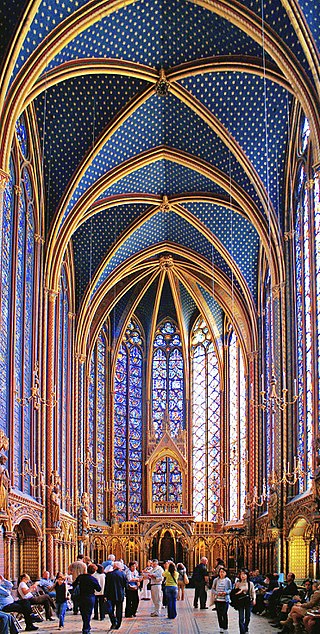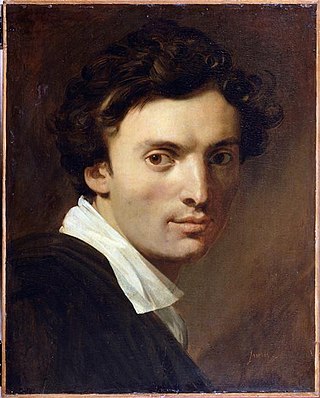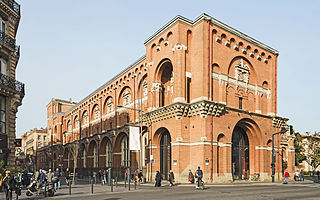
The Sainte-Chapelle is a royal chapel in the Gothic style, within the medieval Palais de la Cité, the residence of the Kings of France until the 14th century, on the Île de la Cité in the River Seine in Paris, France.

The Musée de Cluny, officially Musée de Cluny-Musée National du Moyen Âge, is a museum of medieval art in Paris. It is located in the 5th arrondissement of Paris, bordered by square Samuel-Paty to the south, boulevard Saint-Michel to the west, boulevard Saint-Germain to the north, and rue Saint-Jacques to the east.

Jean-Pierre Cortot was a French neoclassical sculptor.

The Virgin of Paris or Notre-Dame de Paris is a near life-size stone statue, 1.8 metres tall, of the Virgin and Child created in the early 14th century. The statue was commissioned for, and remains in the Cathedral of Notre-Dame in Paris, where it survived the 2019 Notre-Dame fire. It is an example of the court style in Late Gothic sculpture.

Quimper Cathedral, formally the Cathedral of Saint Corentin, is a Roman Catholic cathedral and national monument of Brittany in France. It is located in the town of Quimper and is the seat of the Diocese of Quimper and Léon. Saint Corentin was its first bishop.

Saint-Brieuc Cathedral is a Roman Catholic church located in the town of Saint-Brieuc, Brittany, France, and dedicated to Saint Stephen.

The Musée des Augustins de Toulouse is a fine arts museum in Toulouse, France which conserves a collection of sculpture and paintings from the Middle Ages to the early 20th century. The paintings are from throughout France, the sculptures representing Occitan culture of the region with a particularly rich assemblage of Romanesque sculpture.

Tréguier Cathedral is a Roman Catholic church and former cathedral in Tréguier, Côtes-d'Armor, France. It is dedicated to Saint Tudwal. The church was formerly the seat of the Bishopric of Tréguier, abolished under the Concordat of 1801, when its territories were divided between the Diocese of Quimper and the Diocese of Saint-Brieuc, known since 1852 as Saint-Brieuc-Tréguier.

The Relics of Sainte-Chapelle are relics of Jesus Christ acquired by the French monarchy in the Middle Ages and now conserved by the Archdiocese of Paris. They were originally housed at Sainte-Chapelle in Paris, France and are now in the cathedral treasury of Notre-Dame de Paris.

The Notre-Dame du Kreisker chapel is a Roman Catholic chapel in Saint-Pol-de-Léon in Brittany, France. The 78-metre (256 ft) tower of the "Chapelle du Kreisker" is the highest in Brittany. The word Kreisker means the downtown.

The Musée des Beaux-Arts d'Arras is located in the old Abbey of St. Vaast in Arras, in the Nord-Pas-de-Calais, France.

Ligier Richier was a 16th-century religious sculptor working in Lorraine, France and known in particular for his depictions of scenes from the "Passion of Christ". The various episodes of the Passion, between the arrest and the crucifixion of Christ, as recounted in the Gospels, were increasingly subject to representation in the Arts towards the end of the Middle Ages, in tandem with the growing popularity of the staging of theatrical mystery plays.

The Maître de Chaource was an unidentified sculptor who worked in the late 15th and early 16th century, in the French town of Chaource. While many works are attributed anonymously to him or his atelier, some scholars have identified Jacques Bachot as the artist. There is certainly circumstantial evidence which points to Bachot; he was a contemporary of the Maître de Chaource and often worked in the same locations and works by Bachot such as that in the church of Saint-Laurent in Joinville, of which fragments are held in the Joinville Town Hall, show great similarities to the work of the Maître de Chaource.
Michel Serre (1658–1733) was a Catalan-born French painter.
Roland Doré was a 17th-century sculptor and his workshop or "atelier" produced many sculptures for the enclos paroissiaux or "parish church enclosure or closes" of Brittany. In particular his work can be seen on calvaries and in the church's south porch. He was born in 1616 and died in 1660. Little detail of his life is known but it is recorded that he practised as an architect in Landerneau, as well as running his workshop, and was recorded as calling himself the "Sculpteur du Roi". His works, all of an ecclesiastical nature, are mainly located in Léon and the north of Cornouaille. They can be taken as works by Doré's workshop rather than just by Doré himself. Brittany is particularly rich in calvaries, some of a very elaborate nature. In most cases the calvary involves both the crucifixion cross and side crosses or gibbets bearing the good and the bad robbers. Below this, on the crosspieces, were statues of those present at the crucifixion. A feature of Breton calvaries is that most of the statues were carved as a pair and effectively back to back. Doré's output was prodigious and he worked on nine monuments in Saint-Thégonnec, five in Logonna-Daoulas and four in the parish of Plougastel-Daoulas. He also received four commissions to work in Hanvec, three in Guiclan, Irvillac and Lampaul-Guimiliau and two commissions in Cléden-Cap-Sizun, Hôpital-Camfrout, Landerneau, La Martyre, Plabennec, Pleyben, Plogonnec, Saint-Nic, Saint-Servais and Saint-Urbain.
This is a listing of some of the works of Jean Fréour.

Jean-Marie Valentin, was born at Bourg-des-Comptes in Ille-et-Vilaine on 17 October 1823 and died in Paris on 8 August 1896. He was an architect and a sculptor specialising in religious furnishings such as pulpits, altars and statues. His father Antoine Louis Valentin was a master carpenter working mostly in ebony. He was born in 1784. Jean-Marie first worked at his father's workshop.

Église Saint-Maurice is the medieval parish church of the small town of Soultz, in the Haut-Rhin department of France.
The Treasury of Saint-Denis, kept at the Basilica of Saint-Denis in Paris until the French Revolution, was the main repository of the regalia of the Kingdom of France, including the ancien régime portion of what are now known as the French Crown Jewels. Its surviving items are presently scattered between the Louvre, the Cabinet des Médailles of the French National Library, and other museums.















